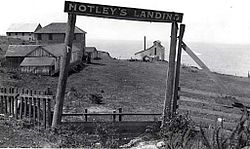Notleys Landing, California
Notleys Landing | |
|---|---|
 Notleys Landing, Big Sur. in 1914 | |
 Notleys Landing Location in California | |
| Coordinates: 36°23′54″N 121°54′13″W / 36.39833°N 121.90361°WCoordinates: 36°23′54″N 121°54′13″W / 36.39833°N 121.90361°W | |
| Country | United States |
| State | California |
| County | Monterey County |
| Elevation | 112 ft (34 m) |
Notleys Landing (also, Notley's Landing) is an uninhabited former community in the Big Sur region of Monterey County, California.[1] It is located near the mouth of the Palo Colorado Canyon 11 miles (18 km) south of the Carmel River,[2] at an elevation of 112 feet (34 m).[1][3]
History[]

Early homesteaders in the area included Samuel L. Trotter (January 23, 1914),[4] George Notley (March 21, 1896),[5] and his brother William F. Notley (May 8, 1901),[6] Isaac N. Swetnam obtained a land patent for property along the Little Sur River and surrounding area on February 1, 1894.[7]
Swetnam and Trotter worked for the Notley brothers, who harvested Redwood in the Santa Cruz area and expanded operations to include tanbark in the mountains around Palo Colorado Canyon. Swetnam married Ellen J. Lawson and bought the Notley home at the mouth of Palo Colorado Canyon for their residence. He also constructed two cabins and a small barn on his patent along the Little Sur River at the site of the future Pico Blanco Boy Scout camp.
The cabin at the mouth of Palo Colorado Canyon still stands. The side of the home facing Highway 1 used to be the rear of the building when the original wagon road ran on the eastern side of the building. William and Godfrey Notley built a landing to ship lumber and to receive goods at the location. It was used heavily between 1903 and 1907, and a small settlement grew up around it for a few years. But as the supply of readily harvestable tanbark and redwood dwindled, the doghole port was little used. It was abandoned in 1937 when Highway 1 was completed.[2][3]
During Prohibition, a dance hall was located just south of the landing, "the wildest dance hall on the coast", according to Big Sur historian Jeff Norman. "During the Prohibition era, the landing served the needs of Carmel's drought-stricken populace. It was conveniently close, but just outside the effective limits of police scrutiny." The bar developed a notorious reputation, and "was frequented by the lime kiln workers, mainly Italians, and every Sunday morning dead Italians would be found in the woods."[8]
Except for the Swetnam cabin, all of the buildings have burned or been dismantled. The concrete foundation of the hoist is still visible.[3]
Current use[]
In 2001, the Big Sur Land Trust bought the approximately 6 acres (2.4 ha) site 11 miles (18 km) south of Carmel for just under $1 million from Rose Ulman, whose family had owned it for several decades. The trust received financial support from the Catherine L. and Robert O. McMahan Foundation, the Barnet J. Segal Charitable Trust, and the Robert V. Brown and Patricia M. Brown Monterey Fund. They planned to open it to the public with hiking trails.[3][9]
Novel[]
Notley's Landing is featured prominently in the novel Les Étrangers, by Patrick Degrâce.
References[]
- ^ a b c U.S. Geological Survey Geographic Names Information System: Notleys Landing, California
- ^ a b Durham, David L. (1998). California's Geographic Names: A Gazetteer of Historic and Modern Names of the State. Clovis, Calif.: Word Dancer Press. p. 930. ISBN 1-884995-14-4.
- ^ a b c d McCabe, Michael (May 18, 2001). "Big Sur Trust buys historic overlook / Notley's Landing was important in timber trade". San Francisco Chronicle. Retrieved 6 October 2016.
- ^ "Samuel M Trotter, Patent #CASF--0005429". The Land Patents. Retrieved 28 July 2016.
- ^ "George A Notley, Patent #CACAAA-090763". The Land Patents. Retrieved 28 July 2016.
- ^ "William F Notley, Patent #CACAAA-092695". The Land Patents. Retrieved 28 July 2016.
- ^ "Isaac N Swetnam, Patent #CACAAA-092685". The Land Patents. Retrieved 28 July 2016.
- ^ Schmalz, David. "Highway 1 transformed Big Sur, and opened its coastline to the world. That has been both a blessing and a curse". Monterey County Weekly. Retrieved 2018-01-02.
- ^ "Central Cost Parks 2000-2011". ConnectingCalifornia.org. Retrieved 9 November 2016.
- Unincorporated communities in California
- Unincorporated communities in Monterey County, California
- Populated coastal places in California



